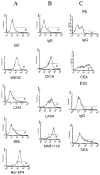Identification of a colorectal tumor-associated antigen (COA-1) recognized by CD4(+) T lymphocytes
- PMID: 14583468
- PMCID: PMC2275323
Identification of a colorectal tumor-associated antigen (COA-1) recognized by CD4(+) T lymphocytes
Abstract
Only a limited number of target molecules have been shown to be recognized by colon tumor-reactive T cells, limiting the options for the development of immunotherapies for patients with colon cancer. The current studies were undertaken in an attempt to generate tumor-reactive T cells that could be used to identify and characterize novel colon tumor-associated antigens. Multiple CD4(+) T-cell clones isolated either from tumor-infiltrating lymphocytes or peripheral blood mononuclear cells that were sensitized in vitro with autologous tumor cells from a colon cancer patient, 1869, recognized autologous tumor cells in a class II HLA-DR-restricted manner. One of the peripheral blood mononuclear cell clones, clone C111, was used to screen pools of clones that were generated from an autologous colon tumor cell line cDNA library. A cDNA clone that was isolated encoded a protein that was termed colorectal tumor-associated antigen-1 (COA-1). This product was recognized in the context of the two autologous HLA-DRbeta1 alleles, HLA-DRbeta1*0402 and DRbeta1*1301. The nucleotide sequence of the COA-1 transcript was nearly identical to multiple expressed sequence tag sequences that encode variants of Socius, a protein that was found recently to bind to members of the Rnd family of GTPases. The COA-1 gene was expressed at relatively comparable levels in colorectal and melanoma tumor cells, EBV-infected B cells, normal B cells, and cultured fibroblast cell lines. However, the gene that was isolated from normal cell types contained a single nucleotide substitution, resulting in an amino acid change near the COOH terminus of the protein. Although the minimal epitope recognized by CD4(+) cells was encoded by sequences that were upstream from this substitution, C111 T cells did not appear to recognize the normal gene product. Therefore, this alteration may either affect the localization or the processing of this gene product, which may at least in part be responsible for the differential recognition of tumor and normal cells.
Figures




References
-
- DeCosse JJ, Tsioulias GJ, Jacobson JS. Colorectal cancer: detection, treatment, and rehabilitation. CA Cancer J Clin. 1994;44:27–42. - PubMed
-
- Harrington DP. The tea leaves of small trials. J Clin Oncol. 1999;17:1336–1338. - PubMed
-
- Rosenberg SA, Packard BS, Aebersold PM, Solomon D, Topalian SL, Toy ST, Simon P, Lotze MT, Yang JC, Seipp CA, Simpson C, Carter C, Bock S, Schwartzentruber D, Wei JP, White DE. Use of tumor infiltrating lymphocytes and interleukin-2 in the immunotherapy of patients with metastatic melanoma. Preliminary report. N Engl J Med. 1988;319:1676–1680. - PubMed
-
- Mukherji B, Chakraborty NG. Immunobiology and immunotherapy of melanoma. Curr Opin Oncol. 1995;7:175–184. - PubMed
-
- Riethmuller G, Holz E, Schlimok G, Schmiegel W, Raab R, Hoffken K, Gruber R, Funke I, Pichlmaier H, Hirche H, Buggisch P, Witte J, Pichlmayr R. Monoclonal antibody therapy for resected Dukes’ C colorectal cancer: seven-year outcome of a multicenter randomized trial. J Clin Oncol. 1998;16:1788–1794. - PubMed
MeSH terms
Substances
Grants and funding
LinkOut - more resources
Full Text Sources
Other Literature Sources
Medical
Molecular Biology Databases
Research Materials
